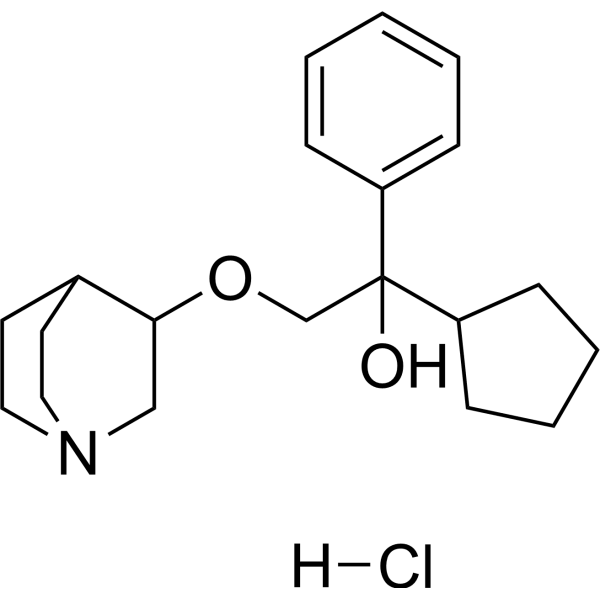
Penehyclidine (Penequinine) hydrochloride, a anticholinergic agent, is a selective antagonist of M1 and M3 receptors. Penehyclidine hydrochloride activates NF-kβ in lung tissue and inhibits the release of inflammatory factors. Penehyclidine hydrochloride can alleviate the pulmonary inflammatory response in rats with chronic obstructive pulmonary disease (COPD) undergoing mechanical ventilation.
| Molecular Weight | 351.91 |
| Formula | C20H30ClNO2 |
| CAS Number | 151937-76-7 |
| Form | Liquid |
| Storage | -20°C, dry, sealed |
| Species | Mouse | Rat | Rabbit | Guinea pig | Hamster | Dog |
| Weight (kg) | 0.02 | 0.15 | 1.8 | 0.4 | 0.08 | 10 |
| Body Surface Area (m2) | 0.007 | 0.025 | 0.15 | 0.05 | 0.02 | 0.5 |
| Km factor | 3 | 6 | 12 | 8 | 5 | 20 |
| Animal A (mg/kg) = Animal B (mg/kg) multiplied by | Animal B Km |
| Animal A Km |
For example, to modify the dose of Compound A used for a mouse (20 mg/kg) to a dose based on the BSA for a rat, multiply 20 mg/kg by the Km factor for a mouse and then divide by the Km factor for a rat. This calculation results in a rat equivalent dose for Compound A of 10 mg/kg.
| Related AChR/AChE Products |
|---|
| Zanapezil
Zanapezil (TAK-147) is a potent, reversible and selective acetylcholine esterase (AChE) inhibitor, it has potent and reversible inhibition of AChE activity in homogenates of the rat cerebral cortex (IC50=51.2 nM). |
| Tacrine
Tacrine is a potent acetylcholinesterse (AChE) inhibitor (IC50=109 nM), also acting as a CYP1A2 substrate agent. |
| THRX-160209
THRX-160209 is a potent antagonist at the M(2) muscarinic acetylcholine (ACh) receptor subtype that was designed using a multivalent strategy, simultaneously targeting the orthosteric site and a nearby site known to bind allosteric ligands. |
| Catestatin
Catestatin is a 21-amino acid residue, cationic and hydrophobic peptide. |
| α-Conotoxin MII
α-Conotoxin MII (α-CTxMII), a 16-amino acid peptide from the venom of the marine snail Conus magus, potently blocks nicotinic acetylcholine receptors (nAChRs) composed of α3β2 subunits, with an IC50 of 0.5 nM. |


Products are for research use only. Not for human use. We do not sell to patients.
© Copyright 2010-2023 AbMole BioScience. All Rights Reserved.
